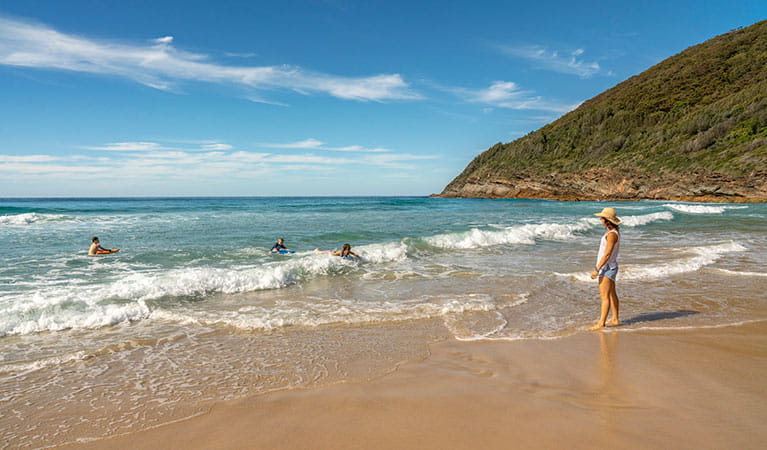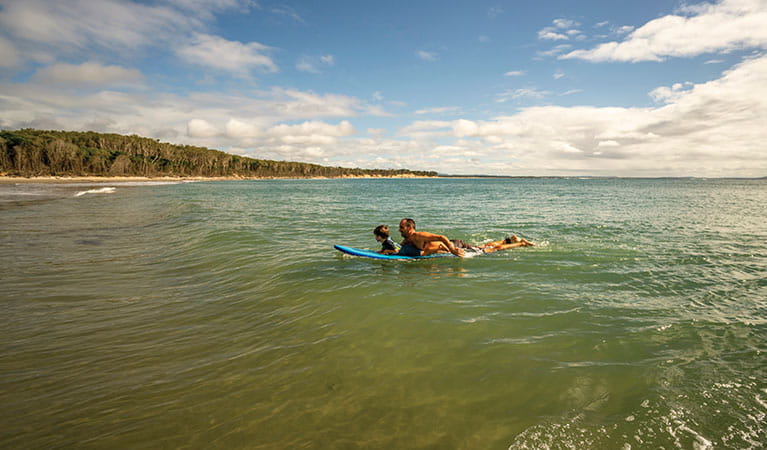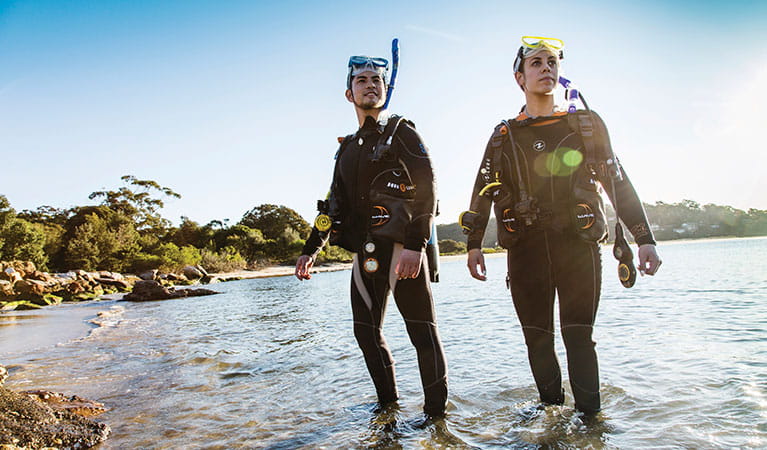Beach safety
If you're exploring coastal national parks, you'll discover many beautiful beaches. While enjoying our beaches, it's important to keep beach safety top of mind. These beach safety tips will help you stay safe in the water and on the sand.
Read more about Beach safety
Before you go
- Check the weather forecast.
- Check if there are any park alerts or closures.
- Download the Emergency Plus app. Mobile phone service is limited in national parks. You may not be able to call for help if you need it.
- Check local swimming advice and current conditions on the Beachsafe website.
- Check if the beach is patrolled or unpatrolled.
Patrolled versus unpatrolled beaches
Most beaches in NSW national parks are wild, remote and unpatrolled. Find out if there are lifeguards at your beach or find the nearest patrolled beach on the Beachsafe website.
What is a patrolled beach? Patrolled beaches are monitored by professional surf lifesaving services. You can identify a patrolled beach by the red and yellow flags that are placed on the shore to show you where it is safe to swim.
The safest place to swim is at patrolled beaches, between the red and yellow flags. There are no lifesaving services at unpatrolled beaches and there is no way of knowing if the water is safe.
If it’s not safe to swim, there are plenty of other ways to enjoy the beach – walking, picnicking, bird watching or taking photographs. If you’re exploring rock platforms, it’s important to be aware of waves and slippery surfaces, and check out marine weather conditions. If you intend to fish, read these fishing and rock fishing safety tips.
Know the danger signs
Watch out for rip currents, unexpected waves, steep drop offs, rocks and rapidly changing conditions. The ocean may look perfectly calm, but this can be deceiving and conditions can change rapidly.
What is a rip current? A rip is a very strong and narrow current that pulls out to the sea. It’s nearly impossible to fight against a strong rip – it can pull you away from the beach at the speed of one to two metres per second.
How to spot a rip current
Look for these signs:
- Deeper and/or darker water
- Fewer breaking waves
- Sandy coloured water extending beyond the surf zone
- Debris or seaweed
- Significant water movement.
Tell someone and don't go alone
Don't swim, surf, fish or go to isolated beaches alone. Give your trip details to family and friends who are not travelling with you. Tell them when you expect to return and let them know when you have returned. For longer trips or remote areas, fill in a trip intention form and take a satellite phone or personal locator beacon.
What to wear
- Sunscreen
- Sunglasses
- A wide brimmed hat
- Sun protective clothing. Remember that ultraviolet radiation (UV) levels can be high even on cloudy days.
- Shoes. Sand gets hot too.
- Wear the right protective gear for your activity. For example, wear fins and a leash for bodyboarding, a lifejacket for kayaking, and a lifejacket while rock fishing which is the law in declared areas. Get more advice on water safety gear.
What to bring
- Insect repellent
- A beach umbrella or other sun shelter.
- Drinking water. Consider 2L per person. Take more than you think you’ll need.
- Food and snacks. Take your rubbish with you when you leave.
- First aid kit
- Mobile phone. Download the Emergency Plus app.
Think before you get into the water
Stop
- Don’t rush in, check the area for rip currents.
- Rips and currents can occur even on still days.
- Strong swimmers and locals can also be caught in rips.
- The best way to avoid rip currents is to swim at a patrolled beach.
- If you are swimming at a patrolled beach, always swim between the red and yellow flags.
- Don’t overestimate your swimming ability. If you or your family or friends are not strong swimmers, only swim at patrolled beaches.
Look
- Look for other hazards such as waves, currents, changing water depth and rocks.
- Check the beach hazard signs.
- Be aware of diving into water. Even if you have already checked water conditions, they can change.
- Always supervise children in and around water.
Stay alive
- Know how to respond in an emergency and know what to do if something does go wrong. You may not have mobile reception if you need to call for help.
- If you get caught in a rip, stay calm and float to conserve your energy.
- If you need help, attract attention by raising your arm and calling out.
- If help is not available, float with the rip current as some rips bring you back to shallower water.
- If you are a strong swimmer, you may be able to swim to the side of the rip, towards breaking waves and white water.
- Only swim during daylight hours.
- Don't swim under the influence of alcohol or drugs.
Marine wildlife and stingers
Look out for marine stingers. If you see bluebottles, avoid the water. Leave octopuses alone. The blue-ringed octopus is venomous.
During swimming season, The Department of Primary Industries operates a shark meshing program at selected beaches in Sydney, the Illawarra and Central Coast. Some of these beaches are near NSW national parks. Find out more about the SharkSmart program.



